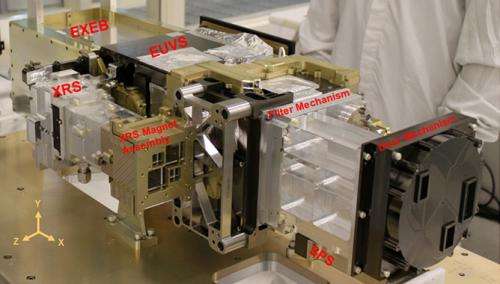GOES-R EXIS instrument ready for integration

The first of six instruments that will fly on GOES-R, NOAA's next-generation of geostationary operational environmental satellites, has been completed on schedule, seven months before its scheduled installation onto the spacecraft.
The instrument, the Extreme Ultraviolet and X-ray Irradiance Sensors, or EXIS, will give scientists a greater measure of the extreme solar energy output from the sun, which can severely disrupt telecommunications, air travel, and the performance of power grids.
"Extreme solar activity has the potential to wreak havoc on the U.S. and global economy, so it's critical that the GOES-R satellite will have this technology in place to monitor for it," said Mary Kicza, assistant administrator for NOAA's Satellite and Information Service in Silver Spring, Md.
GOES-R, scheduled to launch in 2015, will be more advanced than NOAA's current GOES fleet. The satellites are expected to more than double the clarity of today's GOES imagery and provide more atmospheric observations than current capabilities with more frequent images.
"Data from the GOES-R instruments will be used to create many different products, enabling NOAA meteorologists and other users to better monitor the atmosphere, land, ocean and the sun enabling more timely and accurate forecasts and warnings," said Steven J. Goodman, GOES-R program senior scientist, at NASA's Goddard Space Flight Center, Greenbelt, Md.
EXIS will be shipped from the LASP site in Boulder to Lockheed Martin Space Systems Co. in Littleton, Colo., later this year to be installed onto the spacecraft. Lockheed is building the GOES-R spacecraft.
"Completing our first instrument is a major milestone in the satellite building process," said Pam Sullivan, who manages the GOES-R Flight Project at NASA Goddard, and is responsible for the development of the instruments and spacecraft.
The remaining GOES-R instruments to be delivered are:
- the Advanced Baseline Imager, the primary instrument on GOES-R for imaging Earth's weather, climate, and environment;
- Geostationary Lightning Mapper, which will provide for the first time a continuous surveillance of total lightning over the western hemisphere from space;
- the Space Environment In-Situ Suite will consist of sensors that will monitor radiation hazard and warn of high radiation flux events and help mitigate any damage to radio communication;
- the Solar Ultraviolet Imager is a high-powered telescope that observes the sun, monitoring for solar flares and other solar activity that could impact Earth, and
- the Magnetometer, will provide measurements of the space environment magnetic field that controls charged particle dynamics in the outer region of the magnetosphere. These particles can be dangerous to spacecraft and human spaceflight.
NOAA manages the GOES-R Series Program through an integrated NOAA-NASA program office, staffed with personnel from NOAA and NASA, and co-located at NASA's Goddard Space Flight Center in Greenbelt, Md.
"We're just a few years away from seeing significant improvements in the way NOAA will serve the public with better weather forecasts and warnings," said Greg Mandt, director of the GOES-R Series Program.
Provided by NASA's Goddard Space Flight Center




















